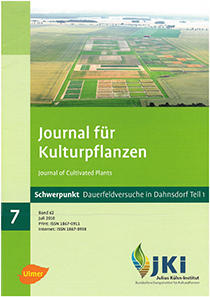Environmental effects and long-term productivity of arable farming affected by crop rotation and strategy of pesticide use
Keywords:
Integrated farming, pesticides, nitrogen balance, energy balance, humus replacementAbstract
On the basis of one 12-year lasting experiment, different crop rotations and strategies of pesticide use were investigated with regard to yield, humus replacement, nitrogen (N) balance, energy use efficiency as well as acute and chronic risk potentials for aquatic and terrestrial organisms due to pesticide application. The experiment comprised one arable crop rotation (winter oilseed rape – winter wheat – winter rye – peas – winter wheat – winter barley, ‘CR 1’) and one fodder crop rotation (winter oilseed rape – winter barley – alfalfa/clover/grass-mixture – winter rye – silage maize – winter wheat, ‘CR 2’) each crop with situation-related pesticide use (100 % HF) or application rates reduced by 50 per cent (50 % HF). Rotations and treatments were located on the same plots in each year. The study comprises the harvest years 2003 to 2006.
Humus requirement could be covered in all crop rotations. Total yield potential of the crop rotations was expressed by grain equivalent (GE) yields and energy output. The different crop rotations influenced yield potential to a larger extent than pesticide use intensity. ‘CR 2’ (72.9 GE ha–1; 192.3 GJ ha–1) slightly exceeded ‘CR 1’ (70.0 GE ha–1; 100.3 GJ ha–1) with respect to GE yields and energy outputs. Averaged across all treatments, N surplus for ‘CR 1’ and ‘CR 2’ were 32.0 and 38.2 kg N ha–1, respectively. Similar to yield, energy efficiency was noteworthy affected by crop rotation and minor by pesticide use intensity. The risk potential due to pesticide application was low in all treatments.
DOI: 10.5073/JfK.2010.07.05, https://doi.org/10.5073/JfK.2010.07.05








